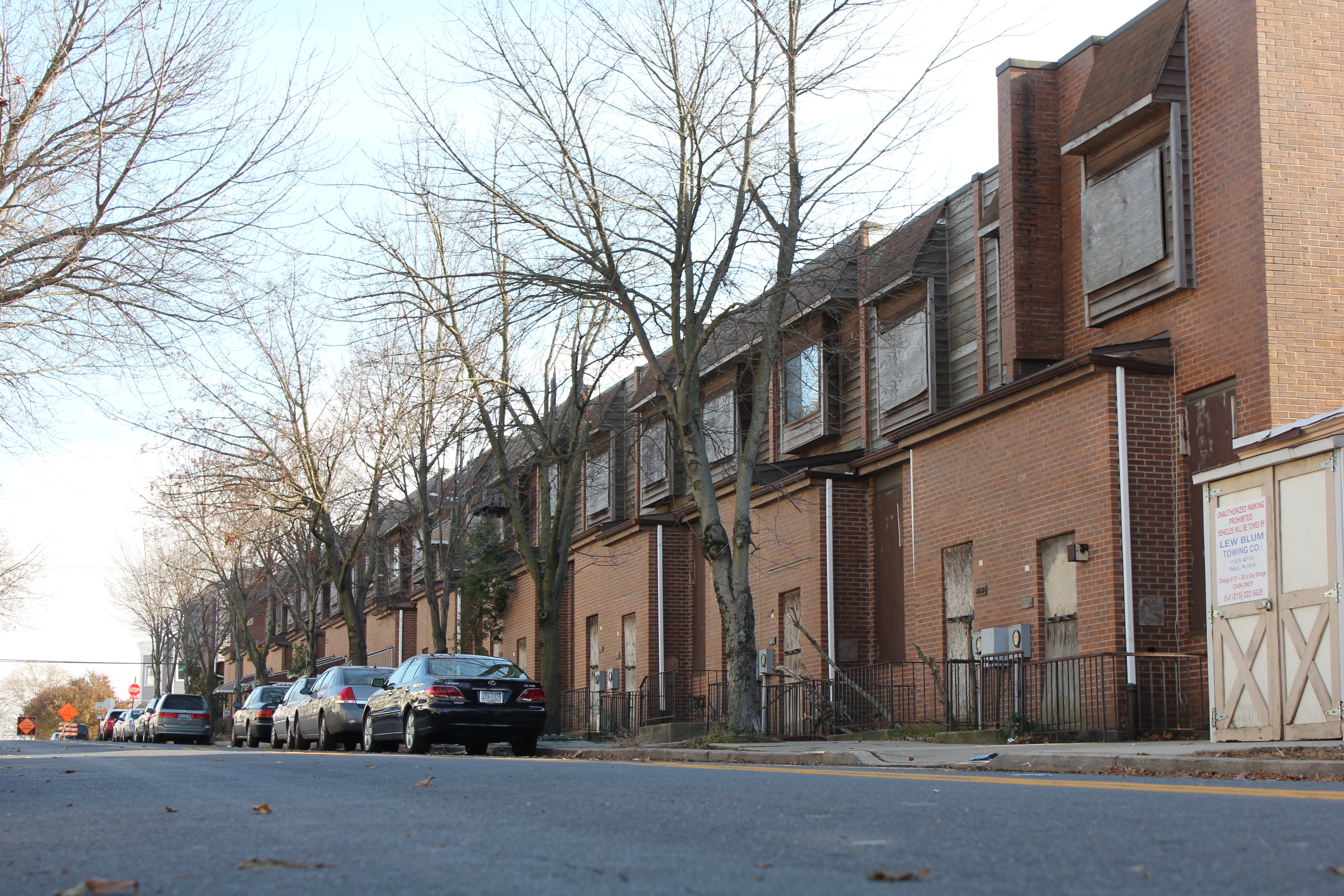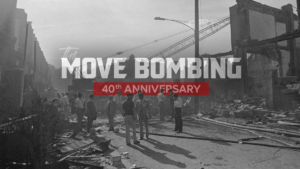MOVE and memory: What is an appropriate monument for 6200 Osage Avenue?

How should the blocks hit by the MOVE bombing and a failed redevelopment effort reflect that past? On Friday, WHYY’s Dave Davies reported that 6th graders successfully applied for a state historical marker to be installed on the 6200 block of Osage Avenue to acknowledge the 1985 bombing. Community Contributor Will Herzog argues that as the Redevelopment Authority considers the next chapter for this corner of Cobbs Creek, it’s time to think about a monument.
Fifteen years ago, then-Mayor John Street offered buyouts to families living in city-constructed houses on the 6200 blocks of Osage Avenue and Pine Street, poorly rebuilt after the city bombed the MOVE house in 1985. Now, the Philadelphia Redevelopment Authority (PRA) is attempting to heal the neighborhood once again.
Late last year, the Redevelopment Authority issued a Request for Proposals (RFP) for a developer to purchase and redevelop 36 houses owned by the city on Osage and Pine. The department expects to announce the selected proposal in May. In its request, PRA was uncommonly considerate, recognizing “[the] developer should also be respectful of the area’s challenged history and the trauma that adjacent residents may have experienced.” Encouraged by the authority’s gesture, Osage Avenue residents are optimistic about the neighborhood’s future.
PRA and Kenney administration should be commended for this acknowledgment and interest in restoring justice to the block. However, we should challenge PRA and its selected developer to go one step further: Any new plan should also reflect the governmental failure and enduring community trauma instead of erasing the block’s troubled history.
The violent history – the destructive fire and deaths of 11 MOVE members and children – is uncontested and well-documented. On March 6, 1986, the Philadelphia Special Investigation Commission resolved: “The hasty, reckless and irresponsible decision by the Police Commissioner and the Fire Commissioner to use the fire as a tactical weapon was unconscionable.”
Today at least 37 of the 61 rebuilt homes are abandoned, plywood covers windows and driveways are empty. The 6200 block of Osage Avenue is an eroded, crumbling, and forgotten monument to past governmental violence and present governmental indifference. As Historian Judith Dupré observes, “Like everything else, monuments require attention in order to retain their meaning; when neglected, they erode, crumble, and disappear from consciousness, if not from view.” But what happens when erosion and inattention themselves are the monument?
The city quickly rebuilt the neighborhood, but the new homes were later condemned. In an interview with Philadelphia Magazine, Amy Laura Cahn, an attorney at the Public Interest Law Center, explains “there was not enough investment. Basically, the community was not worth it.”
Jamila Davis, a spokesperson for the city’s Division of Housing and Community Development, highlights the city’s desire to “make these blocks whole again.” While the current administration is not responsible for previous damage, failure to structurally acknowledge past failures endangers burying history. This is land that must be transformed.
The 2015 pilot phase for Monument Lab, a citywide public history exhibition supported by the Pew Center for Arts & Heritage, William Penn Foundation, and Mural Arts Philadelphia provides insight for the city about ways forward.
In the exhibition’s catalog, Temple University professor Kenneth Finkel’s reflections on preserving Eastern State Penitentiary offers a helpful analogy:
“In the late 1980s, when the fate of Eastern State Penitentiary was up for debate, one group advocating demolition argued that the building stood as ‘a monument to man’s inhumanity to man.’ Others, urging preservation, read the penitentiary as eloquent and important precisely because it embodied the inconvenient, uncomfortable truth. We have, in our midst, a failed nineteenth-century attempt at prison reform that became yet one more overcrowded twentieth-century prison, leaving us to ask: Why hide truth when its expression offers so much?”
Of the 455 monument proposals submitted during Monument Lab’s pilot phase, seven publicly-submitted proposals were made for the Osage Avenue site.
Among the proposals are a community garden, a park, an outdoor structure displaying neighborhood photos and stories, and even a rendition of Robert Indiana’s “LOVE” statue spelling out “MOVE,” embedded in an excavated foundation. Of the six proposals containing a zip code, four were from West Philadelphia residents. Five made explicit design references to MOVE. One acknowledged the tragedy as “our legacy.”
Elaine Golden, a longtime resident of 6200 Osage Avenue, reviewed the seven proposals. She believes that the City needs to recognize several histories: the unity, people, and neighborhood prior to the arrival of MOVE; the horror of a bomb being dropped on a residential neighborhood (with the resulting deaths and displacement of 61 families); and the blight inflicted upon the neighborhood through the city’s neglect. Like other residents, she is baffled at the site’s absence of a historical marker and fears erasure of these histories even as the trauma endures.
While recognizing the deaths of MOVE members, Golden is unsympathetic to having the group as the focal point of recognition. “I came back to the bullhorn nights, using profanity about the neighbors, they didn’t care about them or their kids since they didn’t go to school,” she said. “It’s very hard to get your kids to school the next day when they’re up all night because MOVE was terrorizing us on the loudspeaker.”
In the publication MOVE: Sites of Trauma (2003), architects Mark Gardner, Henry Hsu, and Brian Slocum propose a “phantom MOVE house,” explaining:
“A phantom MOVE house is a painful reminder of lives lost. Rather than fortified or guarded, the lot should be made transparent. The absence of a home on the site would be both a profound acknowledgment of the deaths and provide access for future development (i.e. memorial, park, community space, living machine) in the interior of the block.”
Other architects have proposed a community gathering forum to restore bonds to the neighborhood, or even demolishing homes at the end of the block— creating a connection to Cobbs Creek Park, connecting the community with the land to rehabilitate sense of place and healing.
Now is the time to imagine, recognize, and heal. Rebuilding is a necessary step, but establishing an appropriate monument for 6200 Osage Avenue is just as essential for reinvigoration and restoration.
WHYY is your source for fact-based, in-depth journalism and information. As a nonprofit organization, we rely on financial support from readers like you. Please give today.






